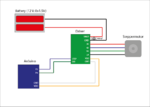Art24
Newbie level 3

Hi everyone,
I am fairly new to Arduino and electronics overall. I am trying to make a motorised camera slider using a Nema 17 Steppermotor (42BYGHW609). To work with an Arduino, I am also using a driver (A4988). To get a 12 V input I have connected eight 1.5 V AA batteries in series (meassured output: 12.8 V). I connected everyting like in the picture (exept a decoupeling capacitor of 100 uF)
I have soldered everything myself. First it didn't work, but then I noticed that when I twisted or pressed the driver in de breadboard the motor was turning. I thought there was a problem with the breadboard, but when I soldered all the pins directly to the driver it stopped working again.
Does anyone know what could be wrong. Maybe a to low current from the batteries or is the driver defect (I got two and both don't work). Or is it the decoupeling capacitor that has a bigger value?
Thank you in advance!
With kind regards,
Art
I am fairly new to Arduino and electronics overall. I am trying to make a motorised camera slider using a Nema 17 Steppermotor (42BYGHW609). To work with an Arduino, I am also using a driver (A4988). To get a 12 V input I have connected eight 1.5 V AA batteries in series (meassured output: 12.8 V). I connected everyting like in the picture (exept a decoupeling capacitor of 100 uF)

I have soldered everything myself. First it didn't work, but then I noticed that when I twisted or pressed the driver in de breadboard the motor was turning. I thought there was a problem with the breadboard, but when I soldered all the pins directly to the driver it stopped working again.
Does anyone know what could be wrong. Maybe a to low current from the batteries or is the driver defect (I got two and both don't work). Or is it the decoupeling capacitor that has a bigger value?
Thank you in advance!
With kind regards,
Art




